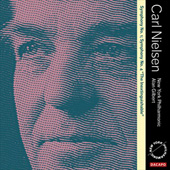

When listening to the Symphony No. 1, Op. 7 by Danish composer Carl Nielsen (1865-1931), one can't help
but feel the strong influence that Johannes Brahms wielded on his symphonic output. Their lives did overlap for over 30 years after all. But it is also obvious
as time marched forward, that Nielsen's outlook on music, and the life around him that impacted it, came from a very different mind-set altered by world events
that Brahms could not have imagined. Whereas the First, finished 3 years before Brahms died, despite its innovative touches, comes from the same structural mould and shares the usual text
book melodic flow and harmonic development forms, the Symphony No. 4, Op. 29 "The Inextinguishable", composed during the
First World War, is characterized by much more pronounced mood swings, a broader spectrum of orchestral colors, and visceral drama. Nielsen himself described its title with the following definition:
"to indicate in one word what only music has the power to express in full: the elemental Will of Life. Music is Life and, like it, Inextinguishable." Despite the
fact that it is definitely a 20th century work, it still contains some potent romantic gestures throughout. For example, the first movement's main idea, introduced at
the 1:27 mark which, upon each return, grows to epic proportions and basks the end of the movement in glowing energy. By contrast, the second movement's
main theme, taken up by the woodwinds, paints a picture of life's elemental bucolic aspects. The jarring effect of the strident strings launching the third movement,
quickly dissipates the calming nature which preceded it, and with bleak and plaintive orchestration that points to Shostakovich, completely alters the landscape.
The final movement paints life with broad strokes into a massive pastiche of all its conflicts and struggles, culminating into a frenzied and furious battle between
two timpanists, only to be crushed by the powerful return of the main theme from the opening movement, this time unambiguous about its affirming splendor and
immortality.
As in their previous release of the Symphonies 2 & 3 (reviewed here), conductor
Alan Gilbert and the New York Philharmonic musicians once again deliver a walloping "live" account of these scores, with
an even balance of power, detail, clarity, and above all a musical pulse and narrative that pulls you in from start to finish, all well captured by the Dacapo
recording engineers. Watch for the final release in this cycle featuring Symphonies 5 & 6 coming out in the near future.
If you would like to purchase this recording in its regular SACD-Hybrid format, simply click on the Amazon link in the left panel of this page. If you would prefer
to download it in DXD (Digital eXtreme Definition), go to the Promates Music Store. Thank You!
Jean-Yves Duperron - November 2014